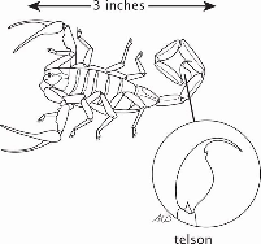Travel Reference
In-Depth Information
The lethal species of scorpions are often found under loose bark or around old tree
stumps. They have a yellow to greenish-yellow color and can be distinguished from other
ure three inches (7.5 cm) in length and three-eighths inch (1 cm) in width. One subspecies
has two irregular dark stripes down its back.
The sting of a nonlethal scorpion is similar to that of a wasp or hornet, although it may
be somewhat more severe and should be treated in an identical manner. (Scorpion venom
is not identical to insect venom, and individuals allergic to insect stings usually are not al-
lergic to scorpion stings.)
Figure 33-3.
Centruroides
scorpion. Enlargement: typical bulb and stinger
Initially the sting of a
Centruroides
species produces only a pricking sensation and may
not be noticed. Nothing can be seen at the site of the sting. (Swelling and red or purple
discoloration are indications that the sting has been inflicted by a nonlethal species.) Pain
follows in five to sixty minutes and may be quite severe. The sting site is quite sensitive
to touch and is the last part of the body to recover. Tapping the site produces a painful,
tingling,orburningsensationthattravelsuptheextremity towardthetorso.(Stingsbyoth-
er species of scorpions can occasionally produce a similar sensation.) Sensitivity may per-
sist as long as ten days, although other symptoms usually disappear within ten hours.
Individualswhohavebeenstungtypicallyareextremelyrestlessandjittery.Youngchil-
dren writhe, jerk, or flail about in a bizarre manner that suggests a seizure. Their move-
ments are completely involuntary. However, in spite of their constantly moving bodies, the
children can talk. Although they appear to be writhing in pain, they usually state that they
do not hurt. Seizures have been described, but the true nature of these events is question-
able. Visual disturbances such as roving eye movements or a fluttering type of movement
known as nystagmus are common. Occasionally children complain that they cannot see,
but nothing abnormal can be found when examining their eyes and sight returns spontan-

Search WWH ::

Custom Search